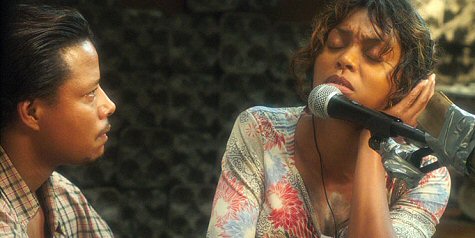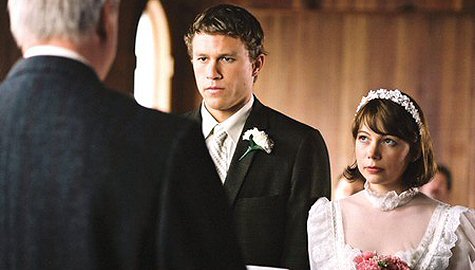A little more than 11 years ago I wrote a piece about how three or four well-reviewed, high-toned, emotionally engaging films didn’t appear, from my November ’05 perspective, to be on their way to attracting what seemed to me like just commercial desserts.
As it turned out two films that I mentioned — Craig Brewer‘s Hustle & Flow (which ended up making $22 million and change) and Curtis Hanson‘s In Her Shoes ($32 million) — did reasonably okay, or at least enough so that no one called them shortfallers. But they didn’t really connect, or not like they should have. You should’ve been there when Hustle & Flow first played at Sundance — it was huge. And when In Her Shoes played the ’05 Toronto Film Festival…wow.
But everything falls away in the end. Who out there has streamed Hustle & Flow or In Her Shoes over the last decade? Even I haven’t, and I can’t really explain why, not even to myself. Hanson died last September, and whatever happened to Brewer? His last feature was a 2011 Footloose remake. Everything disintegrates, particles exploding into space.
Posted on 11.2.05:
An impassioned, extremely well-made film with a sincere emotional current (i.e., one that actually makes you feel something with an application of professional finesse rather than hokey button-pushing) opens after being acclaimed by critics or film festival audiences or both…and what happens?
The public doesn’t respond with much enthusiasm. The movie opens in third or fourth or fifth place, or it opens okay but not as strongly as it should have, and then it’s dead by the second or third weekend, if not sooner.

Terrence Howard, Taraji P. Henson in Craig Brewer’s Hustle & Flow
And then journos start thinking twice about putting this or that insufficiently-loved film on their best-of-the-year lists because they don’t want their editors to think they’re out of touch or living in their own realm.
All because the marketing wasn’t handled in exactly the right way…or the market- ing was fairly on the money and the paying public still didn’t care that much and went to see…whatever….Saw II, Flightplan, The Legend of Zorro, Wallace and Gromit, The 40 Year-Old Virgin, etc.
I’m not talking about a disconnect between effete critics loving the latest downer- head, hard-to-stay-with, impossible-to-really-like art film, and audiences doing their usual avoidance-rejection of anything that doesn’t deliver a rousing visual punch, or that isn’t arresting on some primitive horrific-comedic level.
I’m talking about fairly high-grade, non-elitist, feel-good movies getting the cold shoulder, or at least they’re not getting the love they deserve. Why? I could theorize but I’d wind up sounding like a misanthrope.
I don’t have a long list of examples, but 2005 has availed itself of a few modest calamities in this vein.
The two most obvious are Craig Brewer‘s Hustle & Flow ($22 million so far), a movie with some euphoric musical-high scenes and a fully-earned righteous-uplift finale, and Curtis Hanson‘s In Her Shoes, a movie with a $70 or $80 million quality aura that’s taken in only $30 million so far. I’ve written enough about this film, but it qualifies.

Beautiful Country director Hans Petter Moland, Damien Nguyen during filming
I don’t care if anyone agrees with me, but Hans Petter Moland‘s The Beautiful Country delivered in the general realm I’m describing — it’s a heart movie with a carefully rendered tone — and it was all but ignored.
I’m a bit worried that Thomas Bezucha‘s The Family Stone, a smart, sophisticated family-friendly comedy, might underperform or fail to reach an appropriate-sized audience…partly because it’s opening relatively late in the holidays (12.16) and will lose a bit of its appeal after January 1, 2006. And partly because rural-sector audiences might say, ‘Is this dopey enough? Are these people like the people in my family or…?’
2017 Update: The Family Stone wound up making $60 million and change — a decent tally.
I’ve mentioned this before, but I’m wondering more and more how much ticket-buying support Ang Lee‘s Brokeback Mountain — easily one of the most emotionally affecting mainstream films I’ve seen this year — will be getting. I’m not predicting anything, but if it gets cold-shouldered…maybe I shouldn’t bring this up.
2017 Update: Brokeback wound up with $83 million domestic, $178 million worldwide.
Quality movies obviously do well (or fairly well) from time to time, or at least man- age to avoid box-office humiliations. The $28 million earned so far by A History of Violence isn’t bad, given what it is. The Constant Gardener‘s nearly $33 million domestic gross is a moderately satisfying thing…depending on your attitude. Intriguing cultivated-audience films all seem to top out in the high 20s or low 30s.
We all know about disparate movie appetites making a world. There are Saw II fans vs. fools for Capote. It’s not a crime to like primitive boilerplate films which (here comes a troublesome statement) are primarily made for people who lead straight-from-the-shoulder, not-deeply-examined, Carl’s-Jr.-salad-bar lives, and there are films for those with somewhat more developed interiors…folks who’ve gone to college, grown up a bit, read a few books.

Heath Ledger, Michelle Williams in Brokeback Mountain
What staggers me is when the instinctuals, who obviously comprise the majority, blow off films that are relative no-brainers and are also emotionally shrewd and affecting. I’ve always presumed people of all stripes and persuasions go to movies mainly to feel something profound…to connect with this or that lump-in-the-throat emotion that they’re not experiencing all that much in their day-to-day lives…but maybe not.
I know that Dylan, my extremely bright (i.e., smarter than me) 15 year-old son, doesn’t care at all for lump-in-the-throat movies. He’s partial to intensely visual movies, naturally, and stays away from anything that smells square or schmaltzy.









